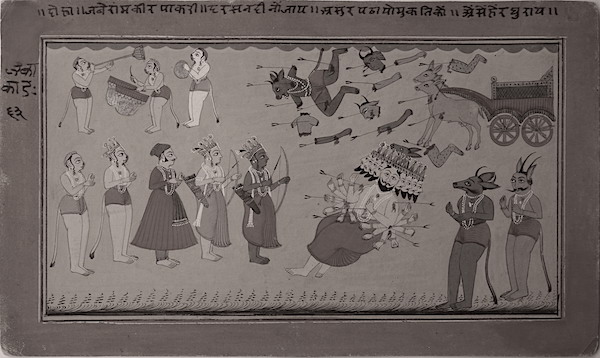Long before Superman or Batman, there was Hanuman, the original superhero. But he wasn’t just all brawn. He was a consummate all-rounder. He was intelligent, patient, compassionate, ready to help, graceful, devoted to a larger cause, humble, and of course immensely strong. Born in a family of monkeys, to King Kesari and his wife Anjana, Hanuman grew up to be multi-skilled. His pivotal role in the Ramayana is known to many. He is revered not only in India but pretty much the whole of Southeast Asia, albeit in different forms and with varying legends. I daresay he has a greater fan following than most other superheroes.
When Rama and Lakshmana are kidnapped by Mahiravana (Ravana’s brother) and taken to Patala (netherworld), Hanuman goes to rescue them. It is there he finds out that he must at once extinguish five lamps in five directions – North, South, East, West, and Upwards – if he has to vanquish the evil brother of Ravana. At that point, he assumes a five-faced form. Here are five lessons we can learn from the five-faced superhero.
1. Aim for the sun
Even as a young boy, Hanuman leaps into the sky thinking that the Sun is a large mango. As he gets closer and closer to the Sun, he increases his size. Then he gets shot down by Indra. Hanuman’s spiritual father, Vayu, the wind god, gets upset at his son’s fall and empties the universe of wind. As all creatures are on the verge of death, Hanuman is revived and granted eternal life.
A great lesson in this is that if we aim for the sun, we may not get it, but we won’t come up with something petty. Also, we might get shot down in attempting the impossible but the universe will work to ensure that things are set right.
2. A reminder to realize potential
As a young child, Hanuman was extremely naughty. By his antics he would trouble everyone to no end. Even the great saints and sages were not spared. At first, they pardoned him, for he was a mere child. But as his antics continued unabated, the sages got exasperated and cursed him. By that curse, he would forget about his strength and unless he was reminded about it by someone else, he would never realize his true potential.
It would not be incorrect to say that many of us are also victims of such forgetfulness. We doubt our abilities, we second guess our potential, and end up doing things way below what we are truly capable of. We need to be reminded – be it by a close friend, a book, or by witnessing an inspiring performance by someone. And when we finally realize that we are capable of much more, we go ahead and do something that we had hitherto thought impossible.
3. Blessings from everyone
Hanuman decides that if he has to learn from someone, it will be the Sun. At first, the Sun doesn’t agree. He says that he’s really busy running around giving light and warmth to the world. But Hanuman doesn’t budge. His persistence is rewarded and the Sun teaches him everything he knows.
When reviving him after Indra’s attack, Brahma blesses him with a boon that no weapon or human can attack him in war. Shiva gives him the boon of physical and mental strength. Indra grants him immunity from further attacks by his weapon. Vayu gives him the ability to move faster than the wind. Agni gives him the power of never being hurt by fire. Varuna pronounces that he would never be harmed by water. Yama gives him the boon of eternal life. Kama assures him that no woman can seduce him. Kubera grants him the boundless wealth of contentment. In this manner, Hanuman is truly blessed by several gods.
When our deeds are noble and we are upright in our dealings, the eminent ones around us will wish us well. One who is helpful and humble often receives help from unexpected quarters. Persistence in the quest of knowledge always yields fruits. Hanuman is a great role model on that account.
4. Selfless devotion to a higher cause
When Hanuman meets Rama, he finds a greater purpose for his life. To help Rama in his journey becomes a mission. We remember Hanuman even today not because he achieved something great in his life (which he doubtless did) but because he worked tirelessly for a cause that was bigger than him. Without his involvement with Rama and his journey, Hanuman might have remained a polymath at best, and possibly forgotten. His role in the larger scheme of things reserves a place for him in our hearts even today.
Isn’t this true of all superheroes? Without their altruism, they are no different from your average WWF fighter. Their greatness comes from what they have done for others rather than what they have achieved for their own betterment. In our own lives, personal accomplishments might give us joy but helping the world brings renown.
5. The power to adapt to situation
One of Hanuman’s superpowers is that in the blink of an eye, he can shrink to the size of an ant or grow to the size of a mountain. He can become weightless or immeasurably heavy. He can travel by land, by sea, or by air. He runs faster than the wind and flies more dexterously than a bird. His will-power is limitless. This tremendous flexibility gives him the strength to overcome any hurdle.
In our own lives, if we develop the ability to become small – and see things in detail – as well as become large – and see things holistically – then we become better equipped to find solutions. Sometimes, we have to become weightless – free of our ego – and at other times, we have to become heavy – filled with self-respect. We need speed and agility as well as the firm will-power to steady ourselves at other times.
This article was first published in Daily O as part of my column Commonsense Karma.














































